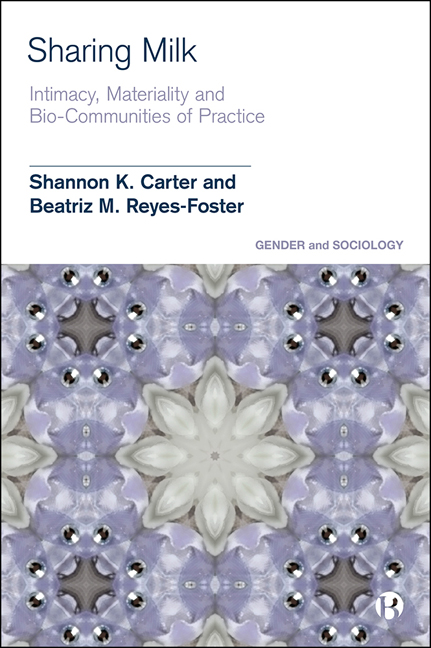Book contents
- Frontmatter
- Dedication
- Contents
- List of Figures and Tables
- Notes on the Authors
- Acknowledgements
- Preface
- 1 Introduction: Sharing Milk
- 2 Theorizing Milk Sharing
- 3 Entering Bio-Communities of Practice
- 4 Milk-Sharing Practices
- 5 The Milk-Sharing Network
- 6 Conclusion
- Notes
- Appendix A Survey Participant Demographics
- Appendix B Interview Participant Demographics
- References
- Index
Preface
Published online by Cambridge University Press: 10 March 2021
- Frontmatter
- Dedication
- Contents
- List of Figures and Tables
- Notes on the Authors
- Acknowledgements
- Preface
- 1 Introduction: Sharing Milk
- 2 Theorizing Milk Sharing
- 3 Entering Bio-Communities of Practice
- 4 Milk-Sharing Practices
- 5 The Milk-Sharing Network
- 6 Conclusion
- Notes
- Appendix A Survey Participant Demographics
- Appendix B Interview Participant Demographics
- References
- Index
Summary
We are very pleased to have this book in a series that aims to bring original sociological thinking to bear on contemporary gender relations, divisions and issues of concern to feminists. It is our aim for the series that it will challenge received wisdom, offer new insights and expand the scope of sociology both theoretically and substantively.
We confess that milk sharing is a topic that we had not thought about sociologically prior to receiving the proposal from the authors of this book. Also, as non-mothers, it was not something we had encountered in our personal lives. However, this series seeks to embrace all aspects of gendered social life using sociological perspectives, and as it is one of the core aims of sociology to render the familiar strange and the unfamiliar comprehensible, and, as feeding infants is a significant area of many women's everyday lives we felt that the book was a good fit. The book illustrates the ways in which milk sharing disrupts the usual body boundaries around women and babies – boundaries which extend the individualism which is dominant in the global North to include breast milk – only the birth mother's milk is generally viewed as suitable and appropriate for her baby, unless of course the choice is made to use manufactured formula, or milk from a breast milk bank is ‘medically’ indicated. The research undertaken by the authors provides data to show how women can work collectively to provide peer milk, as opposed to more formal institutionalized arrangements, to the benefit of both mothers and babies. The in-depth ethnographic approach enables the reader to really understand, not only the reasons behind peer milk sharing, and its utility, but also the social relations and practices which develop through the process. The authors argue that ‘peer milk-sharing communities can be conceptualized as biocommunities of practice where bio-intimacy is created through the exchange of biological material and the establishing of (bio-) intimacy and affective bonds between donors and recipients’. They draw on the concept of ‘biological citizenship’ developed by Nikolas Rose and Carlos Novas, linking this to ‘communities of practice’ through the process of collectivizing individual biological experiences through activism.
- Type
- Chapter
- Information
- Sharing MilkIntimacy, Materiality and Bio-Communities of Practice, pp. xv - xviPublisher: Bristol University PressPrint publication year: 2020

